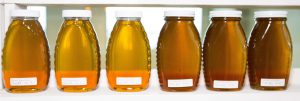Honey is one of the most appreciated and valued natural products introduced to humankind since ancient times. For thousands of years humans have been using honey for medicinal and health-related purposes. There is a now a growing body of scientific research, which is outlined below, demonstrating the antioxidant, anti- inflammatory, and antimicrobial properties of honey.
inflammatory, and antimicrobial properties of honey.
Antioxidants: Antioxidants scavenge and eliminate unstable molecules (i.e., free radicals) that can damage the cells in our bodies. Honey is a dietary antioxidant which means it contains components that can help delay this damage to our cells or tissues. There are over 300 types of honey and the amount and type of antioxidant properties varies for each type. However, honey — in general — provides more antioxidants than white sugar, corn syrup, or agave.
Anti-Inflammatory: While honey has been used as a health product for thousands of years, only recently have studies been conducted to confirm its potential to help reduce internal and external inflammation. After application of honey to wounds and infections, the number of inflammatory cells was shown to be reduced, suggesting honey’s benefits in wound treatment applications.
Antimicrobial: The antimicrobial capacity of honey has been attributed mainly to the presence of hydrogen peroxide, a compound that when used at low concentrations can induce wound healing. Hydrogen peroxide is produced from compounds found naturally in honey. The high acidity in honey is also thought to influence the antimicrobial capacity, because many bacteria cannot survive in acidic environments. Honey makes an effective antimicrobial agent for treating sore throats and other bacterial infections too.
The composition and overall properties of honey make it a food that can provide antioxidant, anti-inflammatory, and antimicrobial benefits. It’s important to remember that color and varietal source play an influential role in the medicinal properties of honey. To learn more, I encourage you to watch the video below to learn how bees make honey!
 0
0
